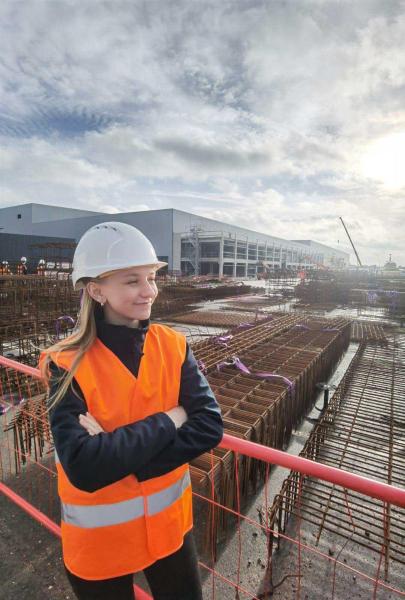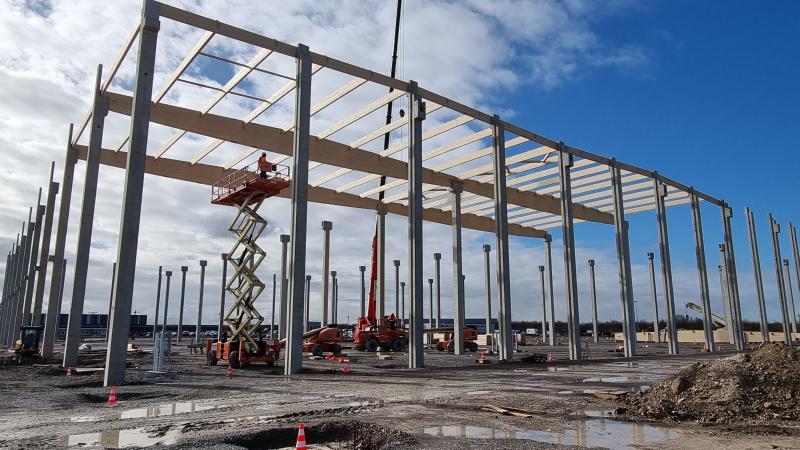A gigafactory for lithium-ion batteries in France will create jobs and boost the European battery industry to drive cleaner mobility
Anastasia Walch-Guinebert has always enjoyed solving problems and figuring out ways to improve things. She also found the continuous innovation in the field of energy transition fascinating. That’s why she works as a process engineer at the Japan-headquartered, Automotive Energy Supply Corporation (AESC), a position that allows her to merge both these interests. At the big, international battery company, she is improving the production of batteries for electric vehicles to ensure that they are safe, high-quality, effective, and environmentally sustainable.

Anastasia Walch-Guinebert
“When there is an issue with the quality of product, we are the ones responsible for assessing the process and finding solutions to the problems,” she says. “This job allows me to have a positive impact on the environment and the world around me.”
With AESC planning to operate a battery gigafactory in Douai, in the Hauts-de-France, by 2025, her role will take on an even greater importance. In the first phase, the factory will produce advanced lithium-ion batteries for Renault’s ECHO 5 (the new electric version of the R5, Renault’s iconic city model from the 70s and 80s) and its crossover utility vehicle, the 4Ever. In its initial phase, the factory will have a combined capacity of up to 9 Gigawatt-hours, with the ability to power 200 000 electric cars each year.
Over time, the Douai site will grow even more, with three expansions planned. By 2030, the facility is expected to produce batteries for electric vehicle with an annual capacity of between 24 to 30 gigawatt-hours.
The European Investment Bank is financing AESC with €337.2 million in direct loans to the project, and up to €112.8 million in indirect loans to participating commercial banks, signed in September 2023.
“AESC is bringing their state-of-the-art know-how to France that will contribute to the sustainable development of the battery industry in Europe” says Olivier Kueny, a senior loan officer at the European Investment Bank who worked on the deal. “The project will also support the reindustrialization of the Hauts-de-France region, known as the new “battery valley”, and accompany Renault’s strategic transition.”
- Read more about a Swedish lithium-ion battery plant helping Europe cut its oil dependence and its reliance on imported batteries
What is a gigafactory?
Gigafactories are colossal manufacturing hubs, where companies usually produce electric vehicle batteries, renewable energy storage solutions, and related technologies. They specialise in producing one popular product on a large scale, unlike regular factories which are smaller and may cater to a variety of manufacturing needs. In Douai, AESC’s gigafactory will focus on the mass production of lithium-ion batteries for electric vehicles.
“There are various types of machines, producing products with unparalleled precision and working in extreme coordination,” says Walch-Guinebert, who trained with the best talents from Japan, China, the United States, and Europe to specialise in gigafactories through a dedicated AESC training programme.

Gigafactories utilise cutting-edge technology and automation to streamline production, aiming to drive down costs and accelerate the transition to renewable energy
Lithium-ion batteries are preferred over sodium, magnesium, or hydrogen batteries for electric cars due to their high energy-density and longer lifespan, which is crucial for cars because of the limited space on board. Since lithium is the lightest metal, less energy is required to move the car, enabling higher efficiency and greater travel distance.
By powering electric cars, lithium-ion batteries can also contribute to cleaner transport. The transport sector remains a major contributor to global warming, producing more than seven billion metric tons of carbon dioxide a year. In 2022, cars and vans were the biggest source of emissions, accounting for approximately 48 % of global transport emissions. Electric cars emit three times less carbon dioxide than gasoline cars, so they could lead the way to clean energy. But they need batteries to run.
And Europe will need its own sources of batteries in case a major international crisis disrupts global supply chains, the way COVID-19 did.
“Europe will need to scale up its battery production capacity to meet its emissions reductions for the green transition,” says Christian Schepens, a lead engineer in the sustainable and digital industries unit of the European Investment Bank.
- Listen to how climate action will change mobility
An automotive ecosystem in northern France
Batteries are indispensable in our modern world. They offer portable power. They store, and deliver renewable energy, charge our electronic devices, and drive our transition towards climate neutrality. Global demand for batteries is rising rapidly and is set to increase 14 times over by 2030.
The European Investment Bank’s support will help AESC build its first plant in France and ramp up the European battery industry, boosting its competitiveness and accelerating the continent’s decarbonisation. The AESC investment is made under InvestEU, a European Commission programme that aims to trigger more than €372 billion in additional investment in Europe from 2021 to 2027.
“This gigafactory is a beacon of progress, not only for AESC but for France and Europe’s green ambitions,” says Matsumoto Shoichi, chief executive of AESC.” We are proud to be able to advance clean mobility by making batteries and electric vehicles more affordable.”

The project is in line with European Union’s target to reduce CO2 emissions in new cars by 55 percent (through banning the use of internal combustion engines in 2040) and a net-zero approach to all ground transports by 2050
AESC’s gigafactory will bring important employment to Douai and the Hauts-de-France region, creating some 1 200 direct jobs over the next three years and up to 3 000 jobs by 2030.
“Douai, once known for its mining industry, has evolved into an automotive hub, with companies like Renault having their manufacturing plants here,” says Walch-Guinebert. “Our project will add to this growing automotive ecosystem.”
- Curious about what connected autonomous vehicles are? Learn about them here
